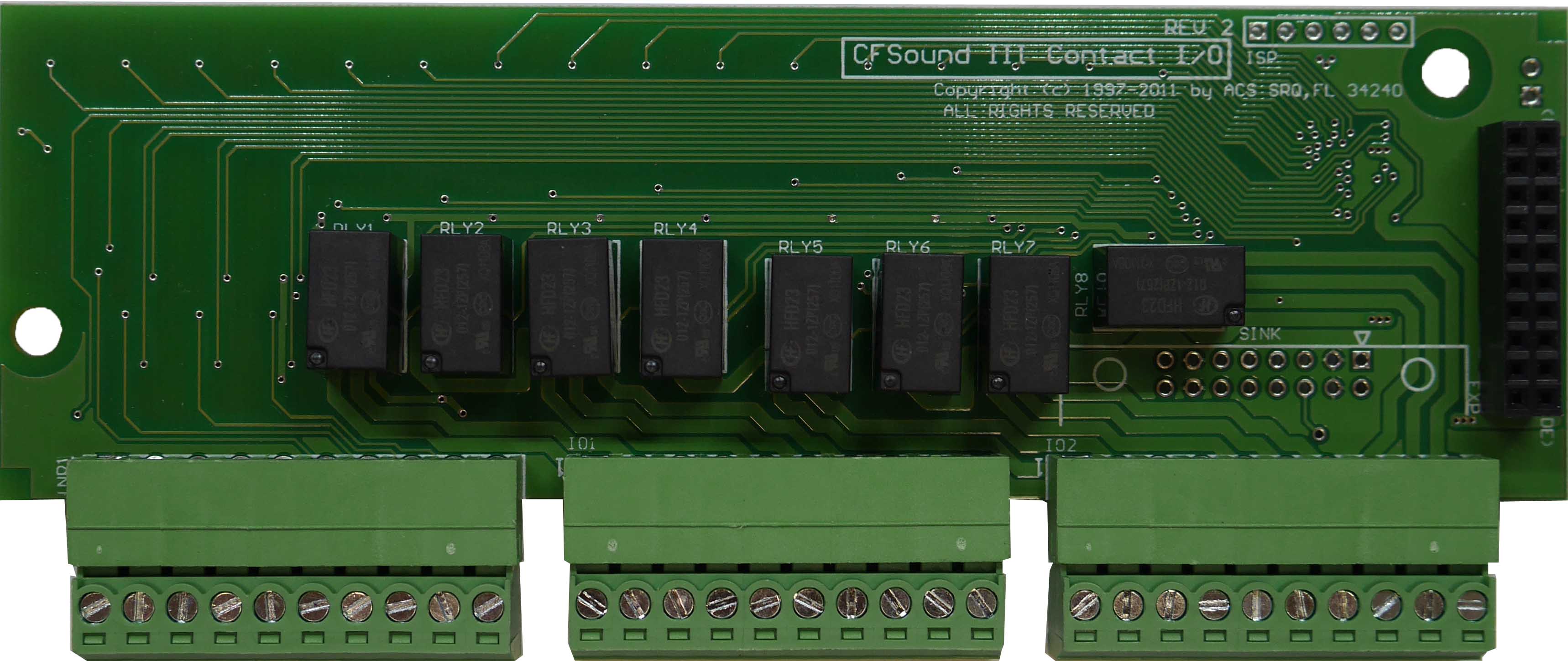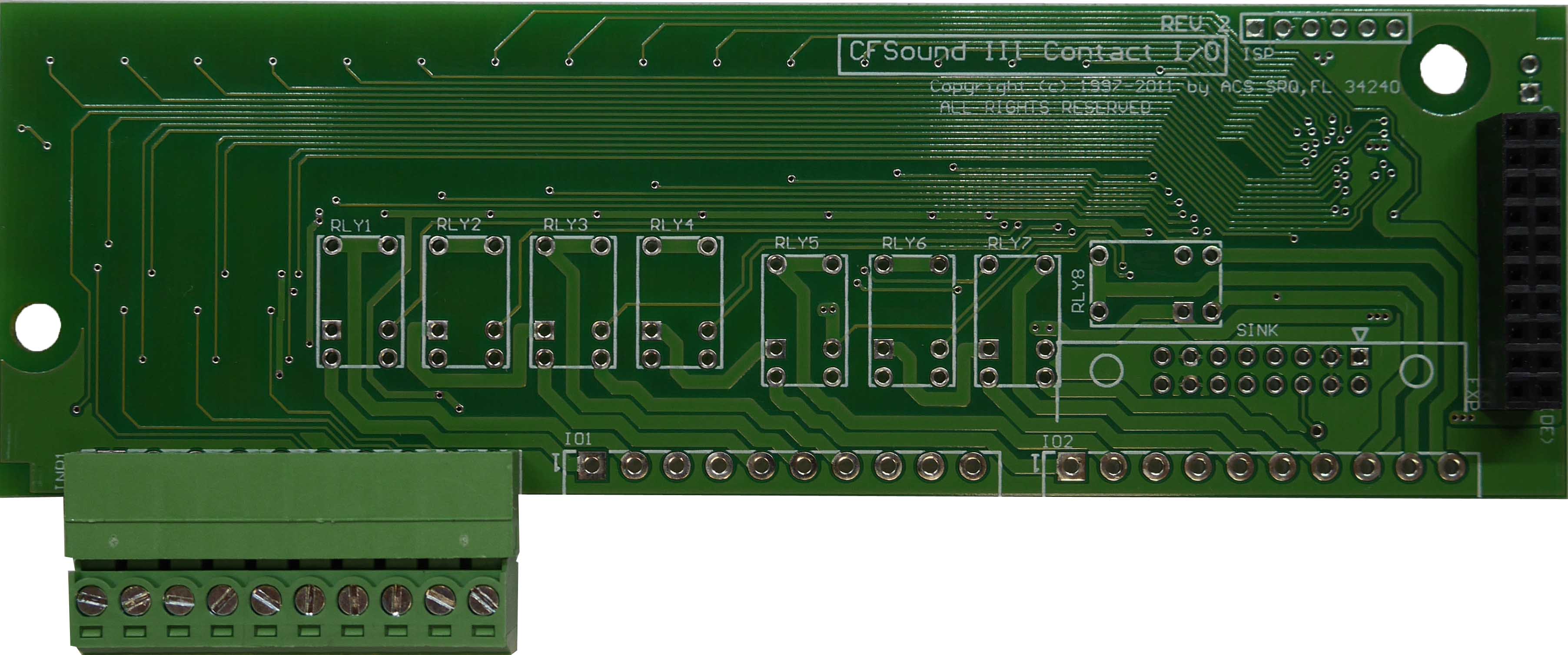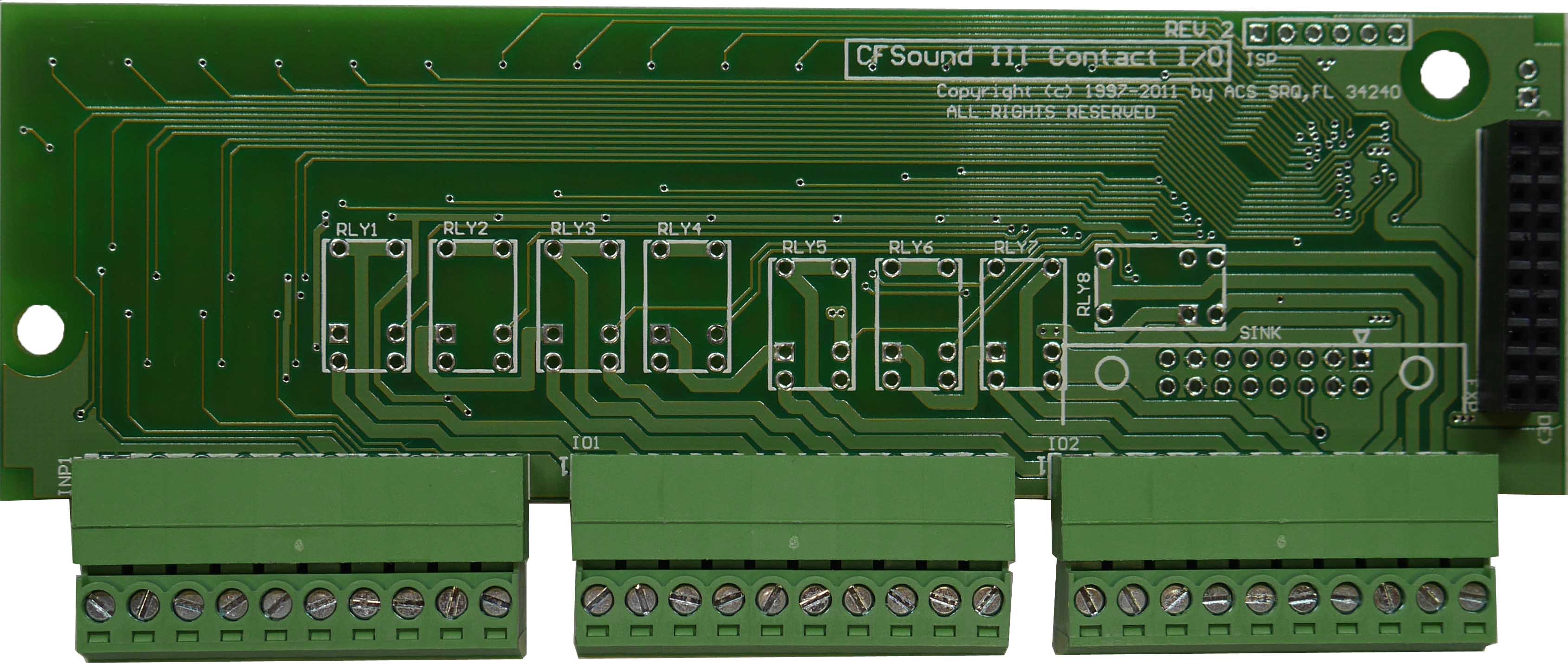CFSound Expansion Modules

The CFSound IV comes with two contact inputs built in, and one PTT(Push To Talk) output relay built in. You can add up to 48 contact inputs and/or up to 16 contact outputs by installing up to two I/O modules in the CFSound IV. wiring examples.
INPUTS - The two built in contact inputs can be used to trigger(start or play while)the corresponding audio files. Each input is considered active when it is connected to ground(wiring examples). This allows the use of Push Buttons, motion sensors, and more on each contact input. Additional contact inputs can be added by installing up to two contact I/O or Sense modules in the CFSound IV. The first two characters of an audio files filename make it correspond to the matching contact input. An example would be that when audio file with "01C" in the first three characters of the filename, plays when contact input #1 closes. An audio file with "01O" in the first three characters of the filename, plays when contact input #1 opens. Adding a "P" after the "01C" or "01O" causes the audio file to only play while the contact input open or close is active
OUTPUTS - The built in PTT contact output relay activates when any audio file plays other than background(files with a "B" after the first two characters of the filename) audio files. Additional contact outputs can be added by installing up to two contact I/O modules in the CFSound IV. When a sound plays, the corresponding relay on the installed contact I/O module activates. An example would be that when audio file #1 plays, contact output relay #1 closes. You can use the contact output relays to turn on corresponding lights when an audio file is being played. The contact output relays can also be used to route the audio file being played to a corresponding speaker.
When using the built in BASIC on the CFSound IV , any contact input can be used to play any audio file, or trigger any event using the @CONTACT, @OPENING, or @CLOSURE variables. Additionally, any contact output can be turned on or off at any time with the BASIC @PTT & @CONTACT variables.
Available IO Modules
Contact IO 8

|
|
The Contact IO 8 module would be used to add eight additional switch/motion sensor inputs, and eight additional relay outputs to the CFSound
IV. Uses could include; Turning on up to eight different corresponding lights when up to eight different audio files are played. Using the built in BASIC to turn individual or multiple relay outputs on & off during the playout of a single or multiple audio file. |
|
|
8 Contact Inputs(Optically isolated - connect to Ground to activate input**)
.15" Pluggable terminal blocks are used for connections
Contact Sense 8

|
|
The Contact Sense 8 module would be used to add eight additional switch/motion sensor inputs to the two switch/motion sensor inputs built into the CFSound
IV for a total of ten. Uses could include; Triggering eight additional audio files with switches or motion sensors. Using the built in BASIC to watch the additional eight switch/motion sensor inputs to play audio files, and/or turn the PTT relay output on & off. |
|
|
.15" Pluggable terminal blocks are used for connections
Contact Sense 24

|
|
The Contact Sense 24 module would be used to add twenty-four additional switch/motion sensor inputs to the two switch/motion sensor inputs built into the CFSound
IV for a total of twenty-six. Uses could include; Triggering twenty-four additional audio files with switches or motion sensors. Using the built in BASIC to watch the additional twenty-four switch/motion sensor inputs to play audio files, and/or turn the PTT relay output on & off. |
|
|
.15" Pluggable terminal blocks are used for connections
DMX512 Lighting Module with eight switch inputs and eight Analog Inputs
 
|
|
The DMX512 module is used to add the industry standard DMX512 lighting control interface to the CFSound IV(Firmware Version 4.9 or later).
The DMX512 module also adds eight additional switch/motion sensor inputs to the two switch/motion sensor inputs built into the CFSound
IV. Also included on the DMX512 Module are eight 0-12V Analog to Digital inputs with 255 steps(8 bits) of resolution. The Analog inputs can be accessed by using the built in ACS BASIC. Uses could include: DMX Master - The DMX512 IO Module default operation is that DMX512 commands are sent to the corresponding DMX device number to fade the device/lamp on when the audio starts playing, and fade the device/lamp off when the sound stops. Further use of the DMX512 IO Module allows xx.DMX text files to be placed on the Compact flash card that are played out to the DMX IO Module when the corresponding audio file is played. This allows the CFSound IV to set a DMX Scene when each audio file is played. DMX Slave - In this mode, the CFSound IV operates as a DMX device. A base DMX address is set in the CFSOUND.INI file located on the Compact Flash card. DMX commands are sent to the CFSoundIV to play audio files by number, adjust the CFSound IV volume, Queue audio files, start the queued audio, and stop the queued audio. Using the built in BASIC to watch the eight analog inputs, allows the CFSound IV to execute functions or play audio files based on the rotation of a knob, value from a sensor, or any device that has a 0-12 analog output or 0-10K resistance. |
|
|
1 DMX512 XLR Female for DMX OUT
8 Contact Inputs(Optically isolated - connect to Ground to activate input**)
8 0-12V Analog inputs with 255 steps(8 bit) of resolution
.15" Pluggable terminal blocks are used for connections
* Outputs can be individually triggered by audio files with corresponding numbers
in the file name. Output stays active for entire duration of corresponding
audio play out.
** Audio
can be triggered on individual input being opened(active to non-active),
closure(non-active to active), open(while not active), closed(while
active)!
Sarasota, Florida
